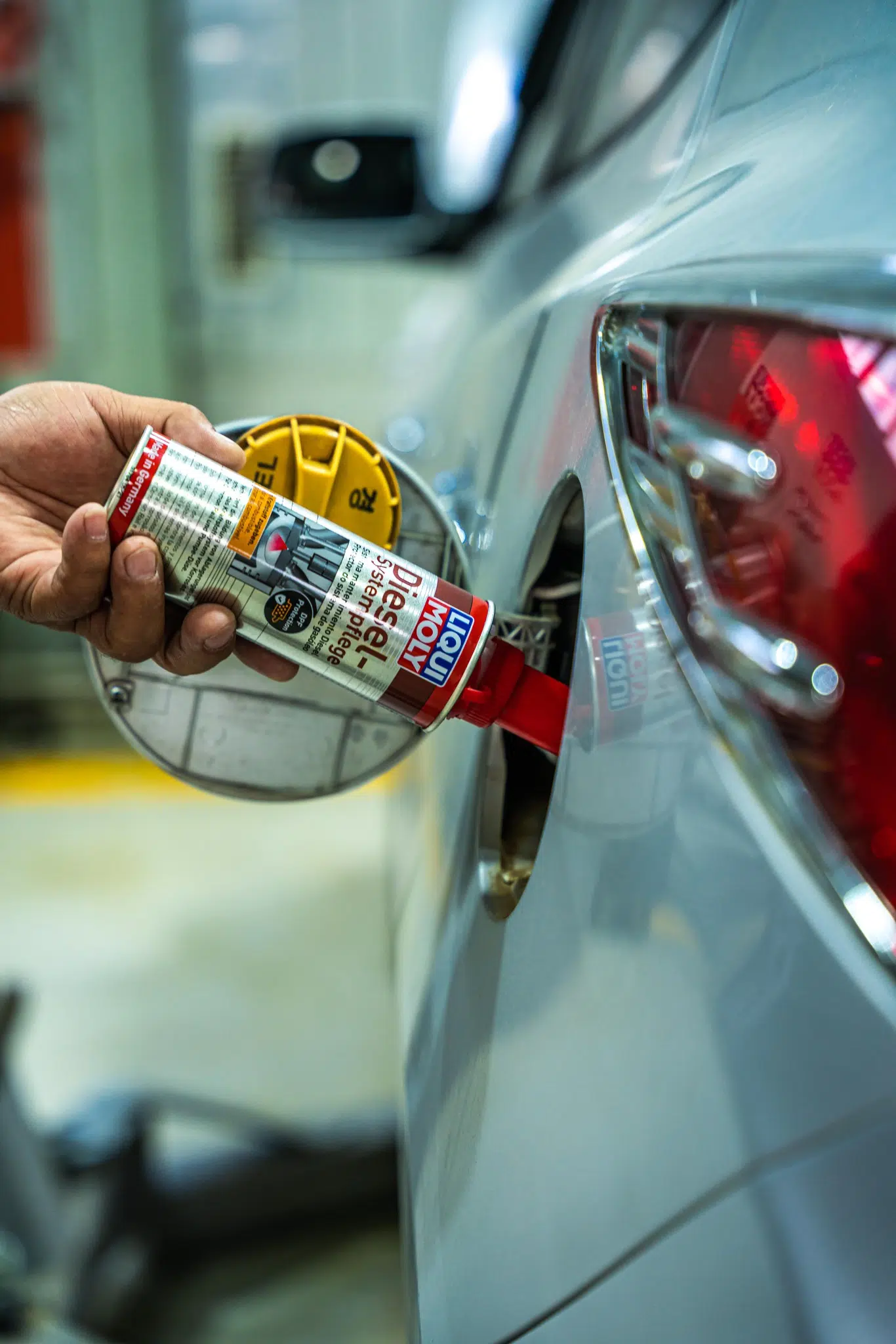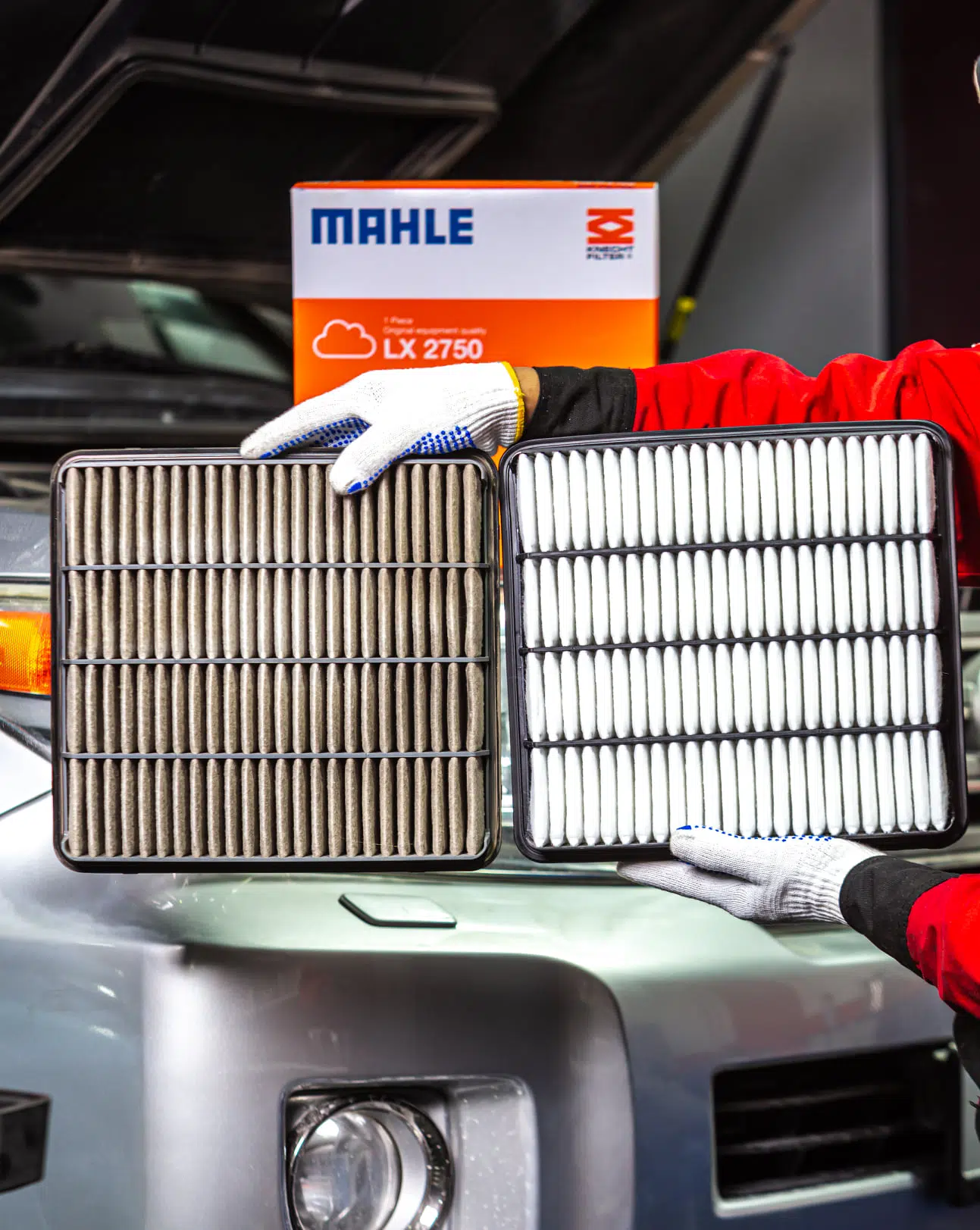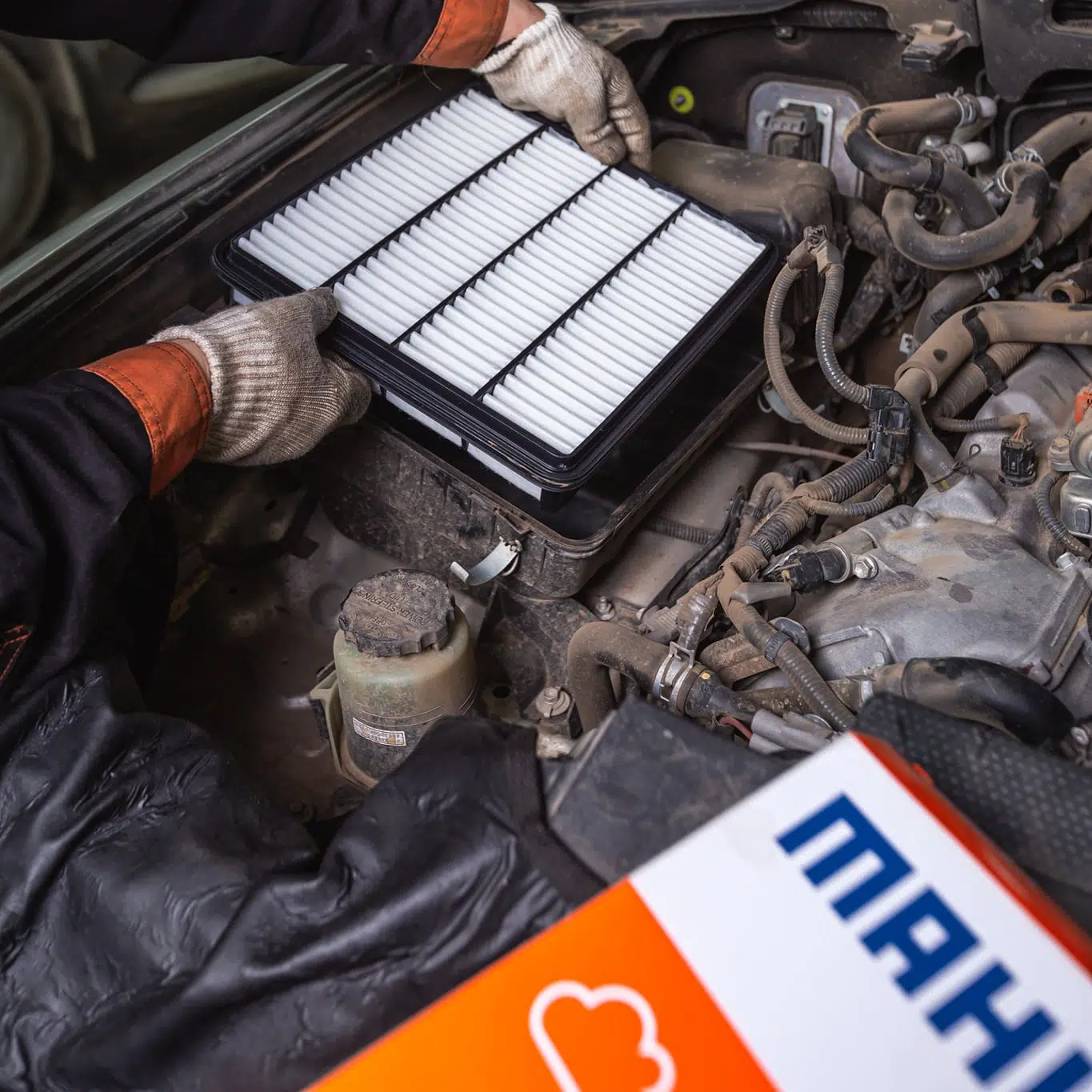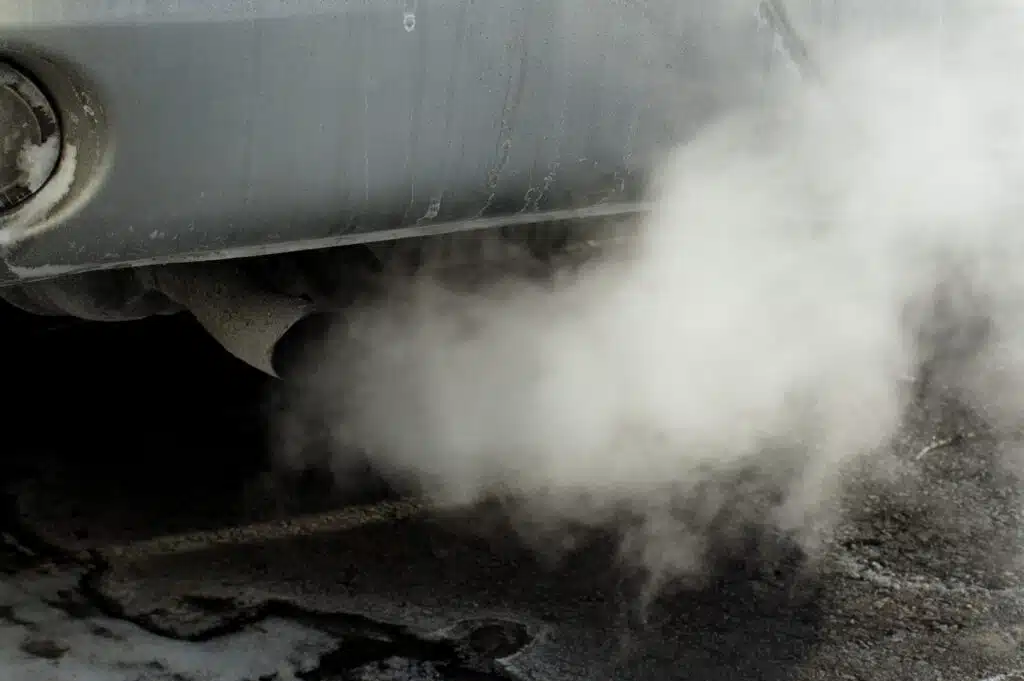White smoke from the exhaust of a diesel engine can indicate a variety of issues. Some possible causes include:
A malfunctioning injector, causing fuel to be injected into the engine at the wrong time or in the wrong amount
A problem with the engine’s compression, causing fuel to be burned inefficiently
Coolant or oil entering the combustion chamber and being burned along with the fuel
A clogged air filter causes the engine to not receive enough air to burn the fuel efficiently. It’s best to take the car to a mechanic for a proper diagnosis.

How To Stop White Diesel Exhaust Smoke?
To stop white smoke from a diesel engine exhaust, the underlying cause of the issue must first be identified and addressed. Here are some common solutions for the causes of white smoke mentioned earlier:
If the issue is a malfunctioning injector, the injector will need to be repaired or replaced.
If the issue is a problem with the engine’s compression, the engine will need to be serviced or rebuilt.
If coolant or oil is entering the combustion chamber, there may be a problem with the engine’s head gasket or other seals, which will need to be repaired.
If the issue is a clogged air filter, the air filter will need to be replaced.
It’s always best to take the vehicle to a professional mechanic for a proper diagnosis and repair.
Additionally, regular maintenance, keeping good quality diesel and regular check-ups can help prevent white smoke from the exhaust.
Get help for your car from our AI Car Expert!
How to treat white smoke from diesel exhaust?
Cleaning or replacing the injectors
How can I clean injectors with LIQUI MOLY additives?
LIQUI MOLY offers a range of fuel system cleaning additives that can be used to clean injectors. The specific product and usage instructions may vary depending on the product, so it’s best to consult the product manual or contact LIQUI MOLY directly for guidance.

Here is a general process on how you can use LIQUI MOLY fuel system cleaning additives to clean injectors:
Start by adding the recommended amount of the cleaning additive to your fuel tank. This is usually around 200-300ml for a full tank of diesel or gasoline.
Drive the vehicle for around 20-30 minutes to allow the cleaning additive to circulate through the fuel system and reach the injectors.
If possible, take the vehicle on a long drive to maximize the cleaning effect of the additive.
Refuel the vehicle and repeat the process if necessary, until your vehicle runs smoothly without any smoke emissions.
It’s important to note that, while fuel system cleaning additives can help improve injector function and reduce emissions, they may not be able to fix all issues. In some cases, injectors may need to be repaired or replaced.
It’s always best to follow the instructions of the product and consult professional help if unsure.
Which LIQUI MOLY additive cleans diesel injectors?
LIQUI MOLY offers a diesel injector cleaner additive called “Diesel Purge”. This product is designed to clean and protect diesel injectors and other diesel engine components by removing deposits and buildup. It is added to the fuel tank and can help improve the performance and efficiency of the engine. According to LIQUI MOLY, Diesel Purge is suitable for all diesel engines and is compatible with all diesel fuels, including bio-diesel and diesel from the pump. It’s important to follow the instructions on the product label and consult the engine and vehicle manual before use.

Can I treat white diesel exhaust smoke with LIQUI MOLY Smoke Stop?
LIQUI MOLY Smoke Stop is an additive that is designed to reduce or eliminate white smoke caused by diesel engines. The white smoke is caused by unburned diesel fuel, which is a common issue with diesel engines. Smoke Stop is added to the fuel tank and can help to improve the combustion process, resulting in reduced smoke emissions.

It can help to reduce the amount of white smoke from a diesel engine, but it may not completely eliminate it. If the smoke persists after using the product, it’s important to have a professional mechanic diagnose and repair the issue, as it could be caused by other problems such as worn or damaged engine components, clogged air filters, damaged gaskets, leaks, or other issues.
Improving the engine’s compression
How can I treat bad engine compression?
There are several ways to address poor engine compression, depending on the cause of the problem. Some possible solutions include:
Rebuilding or replacing worn or damaged engine components, such as piston rings, cylinder walls, valves or valve seals.
Replacing a damaged or clogged air filter or cleaning a clogged air intake system.
Checking and replacing any worn or damaged gaskets or seals, such as head gaskets or valve cover gaskets.
Inspecting and replacing any damaged or leaking vacuum hoses.
Checking and adjusting the valve clearance.
Performing a compression test to determine the specific cause of the problem and target the appropriate repair.
Checking the engine timing and replacing the timing belt if needed.
Checking and replacing the spark plugs if needed.
It’s important to consult the vehicle’s manual and have a professional mechanic diagnose and repair the issue, as some of the steps can be complicated and require special tools.
Keep in mind that if the engine has high mileage and/or is showing other symptoms of wear and tear it may be more cost-effective to replace the engine rather than trying to fix it.
Can I clean piston rings with LIQUI MOLY Motor Clean?
LIQUI MOLY Motor Clean is a powerful cleaning agent that is designed to remove carbon and other deposits from various engine components, including pistons and piston rings. It can be added to the engine oil and used during an oil change. It’s not recommended to clean the piston rings with this product alone.
It’s important to note that cleaning the piston rings with a chemical cleaner such as LIQUI MOLY Motor Clean may not be enough to fix compression issues caused by worn or damaged piston rings. If the piston rings are worn or damaged, they will need to be rebuilt or replaced by a professional mechanic.
If you want to use LIQUI MOLY Motor Clean to clean the engine, it is recommended to follow the instructions on the product label and consult the engine and vehicle manual before use. Also, make sure to have the engine oil and filter changed after using the product.
It’s also important to note that using this product may not be compatible with all engine types, so it’s important to check with the vehicle’s manual or consult a professional mechanic before using it.
How to stop coolant from entering the combustion chamber?
Coolant entering the combustion chamber can be caused by a variety of issues, including a blown head gasket, a cracked engine block, or a malfunctioning coolant system. Here are some steps that can be taken to stop coolant from entering the combustion chamber:
Replace the head gasket: If a head gasket is blown, it can allow coolant to enter the combustion chamber. Replacing the head gasket can help to stop the coolant from entering the combustion chamber.
Repair or replace a cracked engine block: If the engine block is cracked, it can allow coolant to enter the combustion chamber. Repairing or replacing the engine block can help to stop the coolant from entering the combustion chamber.
Check and repair the coolant system: A malfunctioning coolant system can cause coolant to enter the combustion chamber. Checking and repairing the coolant system, such as replacing a faulty water pump or thermostat, can help to stop coolant from entering the combustion chamber.
Check the cylinder head and the engine block for warping or cracks, if present they should be rectified.
Check the radiator and hoses, if they are damaged they should be replaced.
Check the engine oil and coolant for contamination.
It’s important to consult the vehicle’s manual and have a professional mechanic diagnose and repair the issue, as some of the steps can be complicated and require special tools.
Keep in mind that if the engine has high mileage and/or is showing other symptoms of wear and tear it may be more cost-effective to replace the engine rather than trying to fix it.
How to replace the engine air filter?

To replace an engine air filter, you will need to locate the air filter housing. This is typically located near the front of the engine compartment and is often a rectangular or cylindrical shape with a removable cover. Once you have located the air filter housing, follow these steps:
Locate the air filter housing and remove the cover.
Remove the old air filter.
Compare the old air filter to the new one to ensure that it is the correct size and shape.
Insert the new air filter into the housing, making sure that it is seated properly.
Replace the cover on the air filter housing and secure it in place.
Start the engine and check for any leaks or problems.

Note: Steps may vary depending on the make and model of your vehicle. It is always recommended to refer to the vehicle’s owner manual for specific instructions.
Frequently Asked Questions (FAQs)
What can cause white smoke from the exhaust of a diesel engine?
White smoke from a diesel engine’s exhaust can be caused by a malfunctioning injector, issues with engine compression, coolant or oil entering the combustion chamber, or a clogged air filter.
How can I stop white smoke from my diesel engine exhaust?
To stop white smoke, you need to identify and address the underlying cause. This may involve repairing or replacing a malfunctioning injector, servicing the engine for compression issues, fixing seals like the head gasket if coolant or oil is entering the combustion chamber, or replacing a clogged air filter. It’s recommended to consult a professional mechanic for diagnosis and repair.
How can I use LIQUI MOLY additives to clean my diesel injectors?
To clean injectors with LIQUI MOLY additives, add the recommended amount of the cleaning additive (usually 200-300ml for a full tank) to your fuel tank. Drive for 20-30 minutes, allowing the additive to circulate through the system and reach the injectors. If possible, go for a longer drive to enhance the cleaning effect. Refuel and repeat if necessary. Always follow the product’s instructions and seek professional advice if unsure.
What is the function of LIQUI MOLY Smoke Stop?
LIQUI MOLY Smoke Stop is an additive designed to reduce or eliminate white smoke emissions from diesel engines, which is often caused by unburned diesel fuel. It helps improve the combustion process, resulting in reduced smoke emissions. If smoke persists after use, it’s important to seek a professional mechanical diagnosis.
How do I replace the engine air filter in my vehicle?
To replace an engine air filter, locate the air filter housing in the engine compartment, typically near the front. Remove the cover, take out the old filter, and compare it to the new one for size and shape accuracy. Insert the new filter, ensuring it’s seated properly. Replace and secure the housing cover. Start the engine to check for issues. Always refer to the vehicle’s owner’s manual for specific instructions.
